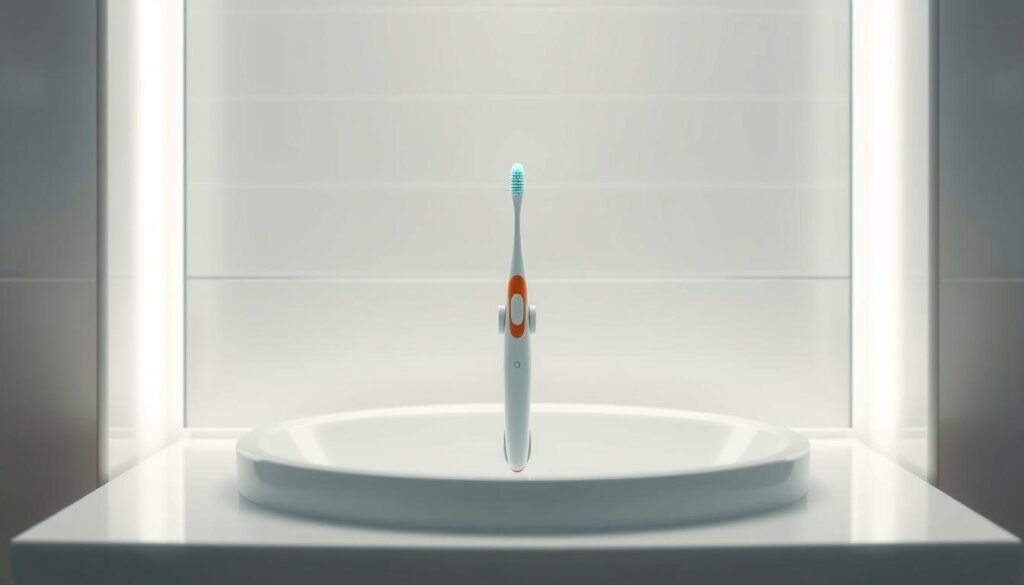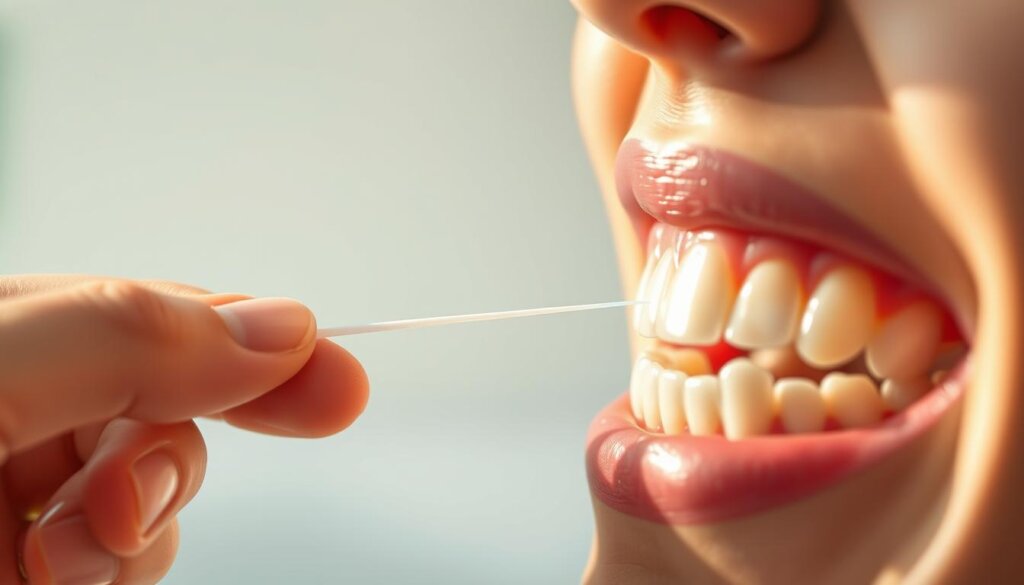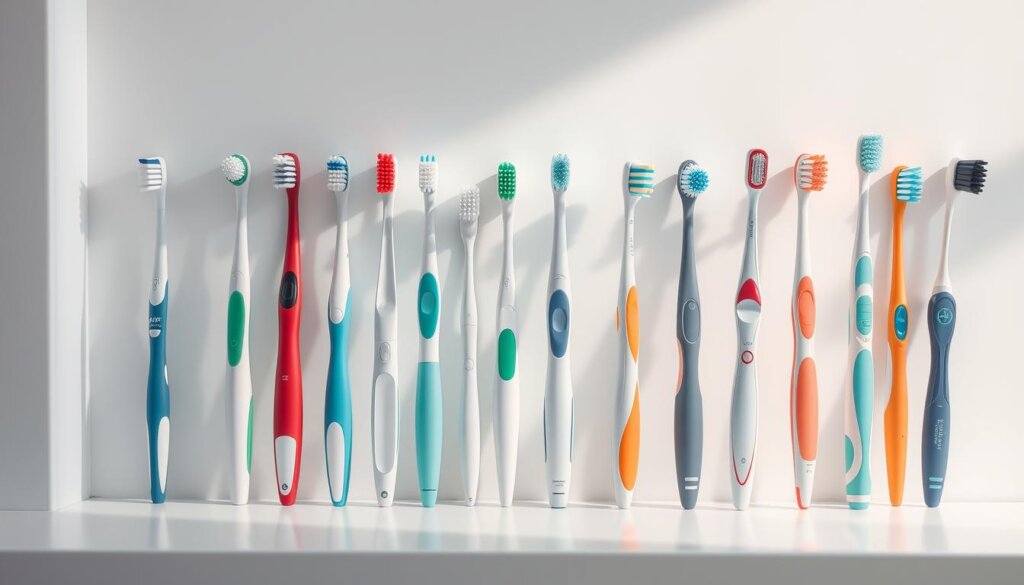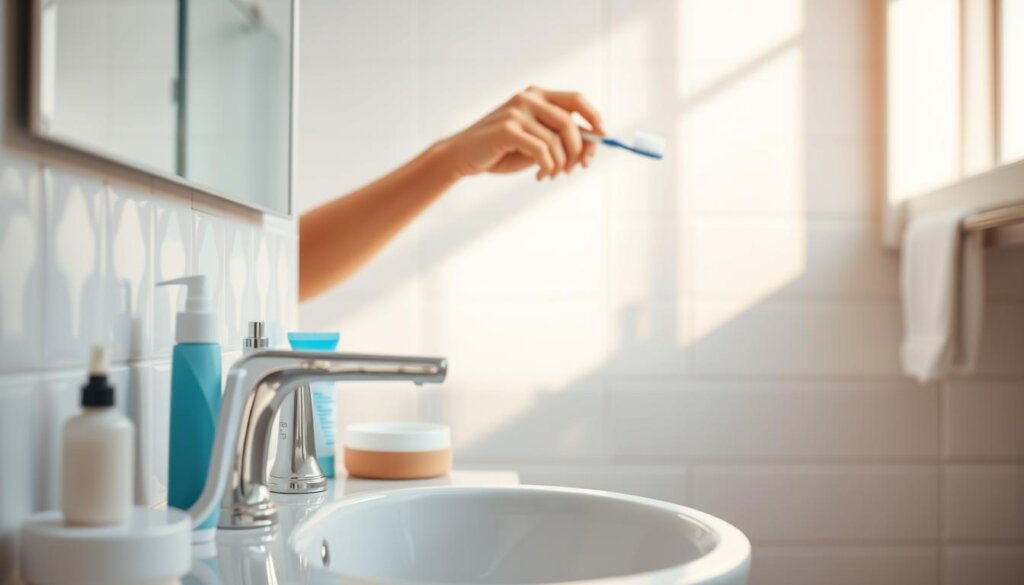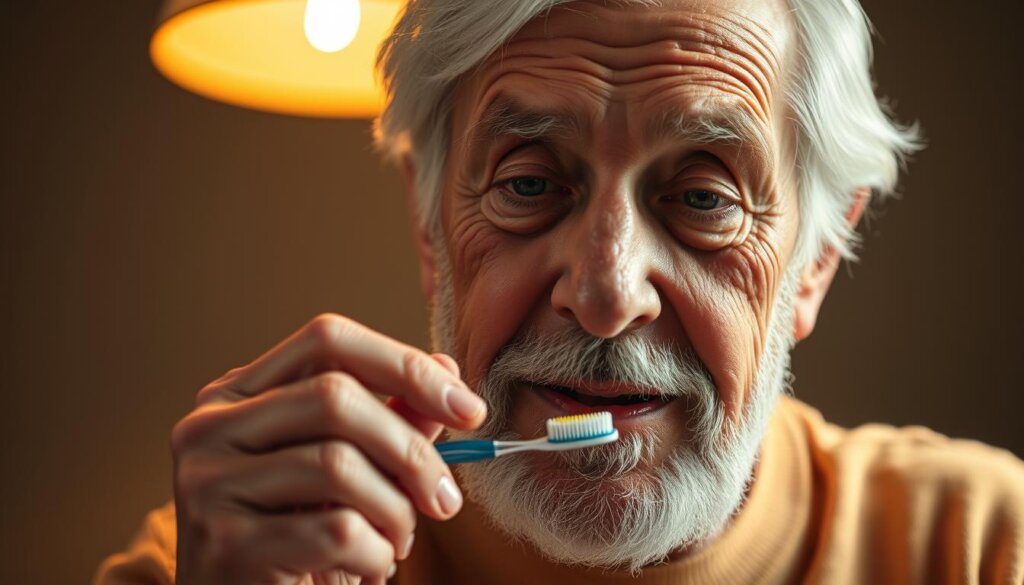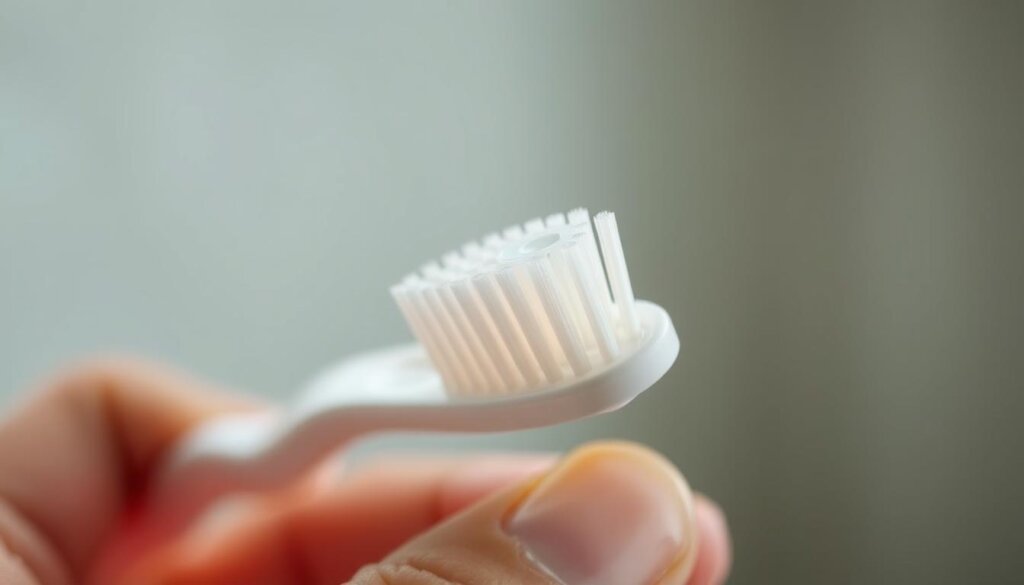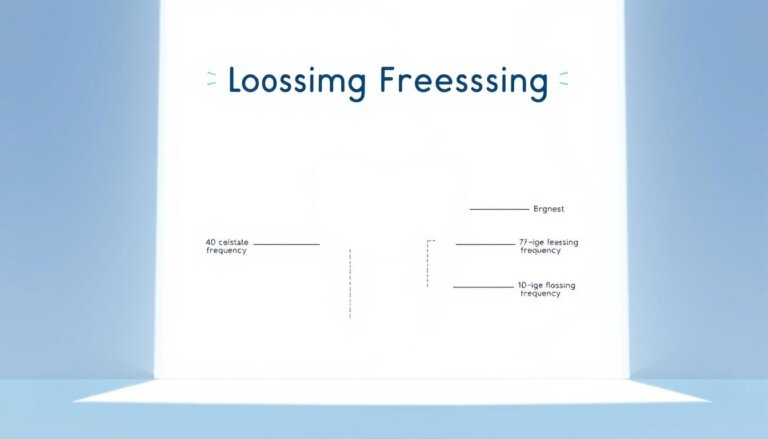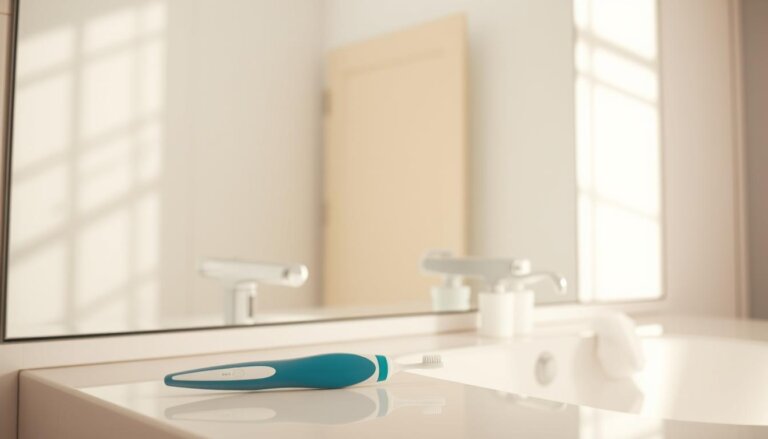How Often Should I Brush My Teeth Each Day?
Life is busy, but daily habits matter a lot for our health. Especially when it comes to keeping our teeth clean. Though most people know brushing teeth is key for good health, only 1 in 10 do it twice a day as suggested. This shows many are still unsure about teeth brushing frequency. It’s a wake-up call to get back to the basics of dental care and oral hygiene.
Figuring out how often should I brush my teeth each day is crucial. It’s not just about checking a box. It helps get rid of plaque and leftovers in your mouth. By brushing regularly, you protect your enamel from cavities and stop tartar from getting worse. We’ll look into the best teeth brushing frequency to keep your oral health great.
Key Takeaways
- Brushing twice a day is the cornerstone of effective daily tooth brushing.
- Dental care experts at the American Dental Association endorse a twice-daily brushing routine.
- The right teeth brushing frequency plays a vital role in preventing dental issues.
- Understanding how often should I brush my teeth each day is paramount for oral health.
- Adhering to recommended brushing practices can minimize the risk of cavities and tartar.
- Quality oral hygiene routines contribute significantly to overall health and wellness.
- A bi-daily brushing habit maintains not just dental health but can reflect on one’s general quality of life.
Introduction to Dental Health
Keeping great dental health is crucial not just for your mouth but for your whole body. A solid dental hygiene plan helps prevent many tooth and gum problems. Let’s look deeper into oral health tips and how they make daily dental care important.
Importance of Oral Hygiene
Oral health tips include brushing, flossing, and eating right for your teeth. Brushing and flossing clean away food and plaque. Plaque is a bacteria film that harms teeth and can cause cavities if not cleaned.
Consequences of Poor Dental Care
Not caring for your teeth can cause big problems like periodontitis. This gum infection harms tissue and bones if not treated. Also, bad dental health can lead to heart disease and diabetes. This shows how vital good oral care is.
Recommended Brushing Frequency
Having a strong brushing routine is key for keeping your mouth healthy. The American Dental Association says you should brush twice a day. This keeps plaque away and stops cavities, which is important for everyone. Learning and sticking to these rules can help you have healthy teeth for life.
American Dental Association Guidelines
The ADA recommends brushing for two minutes, twice daily. This is the best way to fight plaque and gum disease. Remember to use fluoride toothpaste and a brush with soft bristles.
Variations for Different Age Groups
The ADA’s main advice stays the same but changes a bit with age. Toddlers should use a tiny bit of toothpaste, while older kids can use more. This stops them from swallowing too much fluoride.
Below, find a table showing the ADA’s brushing tips for all ages:
| Age Group | Amount of Toothpaste | Brushing Technique |
|---|---|---|
| Infants | Smear (rice-sized) | Gentle, circular motions |
| Children 3-6 Years | Pea-sized | Brush along the gum line |
| Adults and Older Children | Pea-sized | Comprehensive brushing covering all tooth surfaces |
Morning vs. Night Brushing
Morning and nighttime brushing play unique roles in keeping your mouth healthy. They work together to keep your mouth clean all day and night. Following the best brushing frequency helps ensure your teeth are well cared for.
Why is brushing in the morning crucial?
- Eliminates morning breath by removing bacteria and plaque accumulated overnight.
- Prepares the oral environment for healthier interactions with food and drinks throughout the day.
- Increases saliva production, which naturally helps to cleanse the teeth and protect against decay.
How does nighttime brushing impact oral hygiene?
- Removes the build-up of food particles and plaque formed from the day’s eating and drinking.
- Minimizes the risk of cavities and gum disease by reducing bacterial growth during sleep.
- Contributes to a longer-lasting clean feeling and aids in better sleep hygiene.
| Time of Brushing | Benefits | Role in Oral Hygiene |
|---|---|---|
| Morning | Freshens breath, stimulates saliva | Kick-starts oral cleanliness for the day |
| Night | Prevents bacterial growth, reduces plaque | Maintains health throughout the night |
For the best dental care, it’s key to brush both in the morning and at night. This method cleans your mouth right away and keeps it safe over time. It shows how crucial consistent oral hygiene is for your teeth’s health.
The Role of Flossing
Flossing is very important for keeping teeth and gums healthy. It works with brushing to clean all parts of your mouth. While brushing cleans the tops and sides of your teeth, flossing gets in between them and under the gums. This stops plaque from building up. Too much plaque can cause tartar, cavities, and gum disease.
It’s crucial to floss every day to keep your mouth healthy. Experts say we should floss once a day. This stops debris and plaque that your toothbrush can’t get to. Flossing every day keeps away gum disease and bad breath. It’s a key part of caring for your teeth.
Embracing recommended flossing frequency is more than a preventative measure; it’s a commitment to sustaining oral health.
How Flossing Complements Brushing
Brushing and flossing together tackle oral hygiene from two angles. Brushing cleans the outside, while flossing handles the spaces between teeth. This team effort lowers the chance of getting dental problems. It shows how crucial flossing is for dental health.
Recommended Flossing Frequency
Flossing should be part of your daily routine for the best results. Doing it often stops plaque in areas your toothbrush can’t reach. Aiming to floss once a day is ideal. This helps keep your mouth clean and stops plaque-related dental issues.
Choosing the Right Toothbrush
Good dental hygiene highly depends on picking the right toothbrush. Knowing the various types available and their benefits is key. This helps make a choice that meets your unique needs.
In picking a toothbrush, weigh the pros and cons of manual and electric ones. Both have unique features that aid in better dental health. Knowing these perks ensures you’re getting the most out of your brushing.
Manual vs. Electric Toothbrushes
Manual toothbrushes are easy to find and allow you to control the brushing pressure. This helps avoid hurting your gums. Electric toothbrushes, on the other hand, brush for you. They’re great for those who have trouble brushing manually.
Electric toothbrushes often have timers and different power levels. Dentists suggest them for their thoroughness in plaque removal and fighting gingivitis better than manual ones.
Soft vs. Hard Bristles
Choosing the right bristle type is crucial. Soft bristles are recommended as they’re gentle on gums and good at removing plaque. Hard bristles might remove stains well but can harm tooth enamel and hurt gums.
Most people should pick soft bristled toothbrushes. They are especially good for those with sensitive gums or specific dental needs. The American Dental Association (ADA) also suggests soft bristles to prevent harm to your teeth and gums.
Ultimately, selecting a toothbrush should match your dental health goals and what feels comfortable. Talking to a dental professional can also offer helpful advice specific to your oral health.
The Impact of Diet on Dental Health
Understanding the link between our diet and dental health is key. A healthy diet for teeth helps with oral hygiene and stops dental issues. We’ll look at good foods and foods to avoid for dental health.
First, foods rich in calcium and phosphorus are important. These minerals fix tooth enamel damaged by acid.
- Dairy products like milk, cheese, and yogurt
- Almonds and leafy greens for plant-based calcium
- Fish and eggs as great phosphorus sources
On the other hand, we should steer clear of foods high in acid and sugars. They can harm tooth enamel, leading to cavities and sensitivity. These harmful foods include:
- Sugary snacks and drinks that promote bad bacteria
- Acidic fruits like lemons and grapefruit
- Hard candies that increase acid levels in the mouth
To better oral health, here are some oral health tips:
- Balance acidic foods with alkaline water or milk.
- After meals, chew gum with xylitol to lower acid and clean debris.
- Drink plenty of water for healthy saliva flow and enamel repair.
Following these tips helps maintain a healthy diet for teeth. Watching your diet can keep dental decay away and ensure a fresher, cleaner mouth.
Signs You Need to Brush More Often
Early signs of dental problems mean you should look at your brushing routine. Two main signs are more plaque and feeling pain or discomfort. They mean you need to pay more attention and maybe change how you care for your teeth.
Increased plaque build-up turns into tartar if you ignore it. This can really hurt your oral health. Spotting signs like this shows you need to brush more and update your routine. Also, if you have sensitivity and discomfort in your teeth or gums, it’s a sign. It tells you it’s time to improve how you clean your mouth to keep your teeth healthy.
| Dental Health Sign | Recommended Response |
|---|---|
| Increased Plaque Build-Up | Enhance brushing frequency; consider using specialized toothpaste |
| Sensitivity and Discomfort | Consult a dentist; may suggest fluoride treatments or sensitive toothpaste |
Brushing more can ease your discomfort now and protect your teeth later. Always look for these signs. They help you prevent problems and keep your mouth healthy.
Kids and Tooth Brushing
Teaching young ones good brushing habits is key for their oral health for life. Starting early with special children’s dental care routines helps a lot. It impacts their dental health and hygiene as they grow. Here, we talk about the importance of these habits and what’s recommended for kids’ dental care.
Establishing Good Habits Early
Learning to brush right is more than a routine for kids; it’s the start of good dental health. Caregivers are very important in this. They should start teaching this as soon as the first tooth shows. Making brushing fun and educational helps kids want to take care of their teeth.
- Start with a soft-bristled brush when the first tooth comes in.
- Use non-fluoridated toothpaste safe for swallowing until your child learns to spit it out.
- Slowly move to fluoride toothpaste, watching them closely.
Recommended Practices for Children’s Dental Care
Children’s dental care needs certain practices for their growing needs. These steps prevent early tooth decay and other issues. They help kids grow up with healthier adult teeth.
- Watch your kids brush until they can do it well on their own, around age 6 or 7.
- Take them to the dentist by age one or when the first tooth shows.
- Make sure they brush twice a day for two minutes each time.
By following these tips, caregivers can teach kids good brushing habits. This helps kids have healthy smiles and respect for dental hygiene. This approach to children’s dental care keeps them well now and helps with their oral health later on.
Special Considerations for Seniors
As people get older, keeping up with seniors dental health gets more important. They face unique challenges that call for updates in how they care for their teeth and gums.
Age-Related Dental Health Challenges
Aging can lead to issues like gum shrinkage, less saliva, and teeth becoming more sensitive. These problems need gentle, specific care to keep seniors healthy and comfortable.
Adjusting Brushing Routine for Seniors
Changing how seniors brush is vital. They need tools and methods that match their needs, such as less strength and feeling in their mouths. An electric toothbrush with soft bristles is very useful. It makes brushing easier, more effective, and comfortable.
| Age Factor | Recommended Brushing Tool | Brushing Technique |
|---|---|---|
| Reduced Manual Dexterity | Electric Toothbrush | Gentle, circular motions |
| Increased Sensitivity | Soft Bristled Brush | Light pressure, avoid gums |
| Dry Mouth | Brushes compatible with sensitive toothpaste | Avoid alcohol-based mouthwash |
How to Brush Effectively
To brush well, you need to know the right way and stick to a good routine. This means using the correct methods and brushing often. Doing this not only keeps your mouth clean but also stops dental problems before they start.
The brush and toothpaste you choose are important, but how and how often you brush matters more. We’ll show you how to brush properly. This way, you’ll get the most from your daily dental care.
| Aspect | Details |
|---|---|
| Brushing Technique | Hold the brush at a 45-degree angle to your gums and use short, gentle strokes, paying extra attention to the back teeth, tooth surfaces, and areas around fillings or crowns. |
| Duration | Brush for at least two minutes, spending an equal amount of time (about 30 seconds) in each quadrant of your mouth. |
| Frequency | Brush at least twice a day, ideally in the morning and before bedtime, to remove plaque and prevent a build-up overnight. |
| Cleaning All Surfaces | Ensure brushing all surfaces of each tooth – outer, inner, and biting surfaces. Also, brush your tongue to remove bacteria and keep your breath fresh. |
Don’t forget to use a fluoride toothpaste and get a new toothbrush every three to four months. Or sooner if the bristles look worn. Good dental habits are key to your overall health. By sticking to these tips, you keep your mouth and your body healthier.
Common Myths About Tooth Brushing
Many tooth brushing myths and dental hygiene misconceptions can make it hard to care for our teeth properly. It’s important to clear up these myths. This way, everyone can know the truth about how to keep their teeth healthy.
People often get confused about how much they should brush their teeth. This confusion can lead to brushing too little or too much. We’re here to clear up these myths and share the real facts about how often you should brush.
- Brushing right after eating can harm your teeth’s enamel due to the acids in food.
- Brushing more doesn’t always mean your teeth will be healthier. Too much can hurt your gums and teeth.
Now, let’s clear up some more myths:
- Even though it might seem like it, using a hard-bristled toothbrush doesn’t clean better. Soft bristles are safer and just as effective.
- Kids do need to brush as much as adults, but how they brush might be a little different.
Getting these facts right stops bad habits and helps everyone care for their teeth the right way.
Importance of Regular Dental Visits
Good oral health is more than just brushing and flossing every day. It’s important to have dental checkups and professional dental cleaning regularly. These help prevent dental diseases and keep your teeth healthy for a long time. Going for routine dental checkups can catch and fix oral health issues early on.
Also, getting your teeth professionally cleaned every six months does more than make them shine. It keeps your mouth healthy and prevents diseases. This cleaning gets rid of plaque and tartar that your toothbrush can’t. This protects you from gum disease and tooth decay.
| Benefits | Regular Home Care | Professional Dental Cleaning |
|---|---|---|
| Plaque Removal | Limited to surface plaque | Extensivly removes plaque and tartar buildup |
| Cavity Prevention | Helps reduce risk | Significantly decreases the likelihood of cavities with detailed cleaning |
| Gum Health | Can maintain with proper technique | Improves gum health by removing hidden plaque under the gumline |
| Overall Oral Assessment | Not applicable | Provides professional assessment and timely detection of issues |
Including regular dental checkups and cleanings in your oral care is essential. It’s not just advice—it’s vital for keeping your mouth healthy. Doing these things regularly makes sure your smile stays healthy. Plus, it’s good for your overall health and wellbeing.
Additional Oral Hygiene Practices
Adding a few extra steps to your oral hygiene routine can make a big difference. Using mouthwash and dental chewing gums are great additions. These help not just with brushing but also strengthen your mouth’s health.
Mouthwash is a powerful tool for your mouth care toolkit. It cuts down on mouth bacteria. This reduction can lower the chances of dental plaque and gum problems. Used with brushing, mouthwash is key for oral hygiene enhancement.
- It quickly gets rid of bacteria when you can’t brush your teeth right away.
- Some types fight bad breath, leaving your mouth feeling fresh.
- Mouthwashes with fluoride make your tooth enamel stronger and fight off decay.
It’s also good to chew sugar-free gum after meals. This habit boosts saliva, which reduces acid and helps your teeth. Making these practices part of your daily routine can really improve your dental health.
Conclusion: Building a Healthy Routine
To wrap things up, it’s key to note that good dental health starts with a solid routine. It’s all about brushing well and often. Following dental care tips closely can really lower your risk of gum disease and cavities. These issues don’t just hurt your mouth. They can affect your whole body’s health too.
But getting great teeth is about more than just what we do alone. It’s a team effort that involves the whole family. When everyone pitches in, it builds a supportive atmosphere. This is great for kids especially, teaching them habits they’ll use for life. This way, good dental health becomes a family legacy.
We’re dedicated to sharing knowledge about keeping teeth healthy. And we believe strong dentistry practices are fundamental. By making these habits part of our everyday, we look after our health and our family’s too. This keeps everyone’s smiles bright and healthy.

